Our First Tesla Model Y Road Trip Started With a Flat Tire

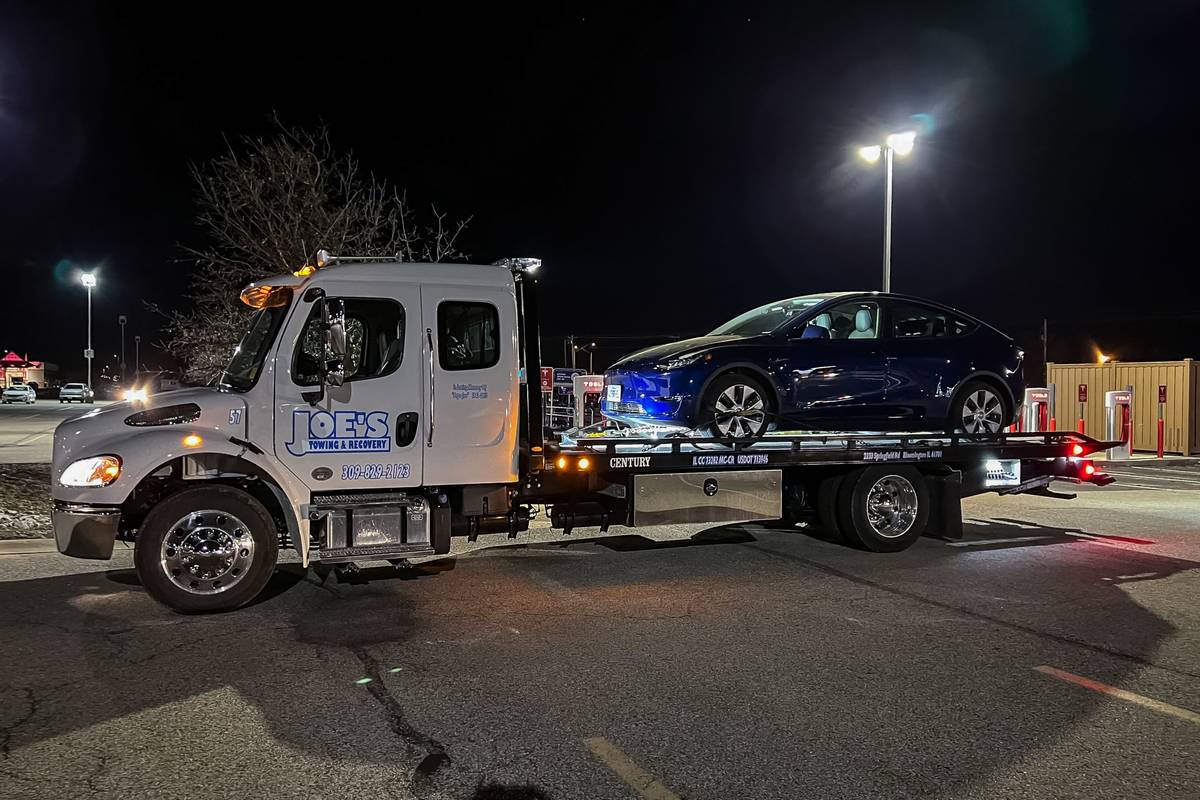
Our first road trip in Cars.com’s Tesla Model Y was anything but dull. It was filled with more charging stops than I’d anticipated and a flat tire. Thankfully, my husband and two teen sons rolled with the delays as we attempted to get from Chicago to a St. Louis suburb for the holidays, a 355-mile trip that we’ve made many, many times. The Model Y was fully loaded with gifts, luggage and four adult-sized people. We definitely put it to the test.
Related: How Was the Build Quality on Our Tesla Model Y?
For this road-trip test, I entered my destination into the Model Y’s navigation and mostly followed its guidance on route and charging points. I ignored its directions for getting out of Chicago in the first leg of the trip, but after getting through the never-ending traffic backup, I let the Model Y decide the route, which it picks based on charge level needed to reach the destination and plots out Superchargers along the way. I used Tesla’s Autopilot, setting the speed for 78 or 79 mph for most of the trip.
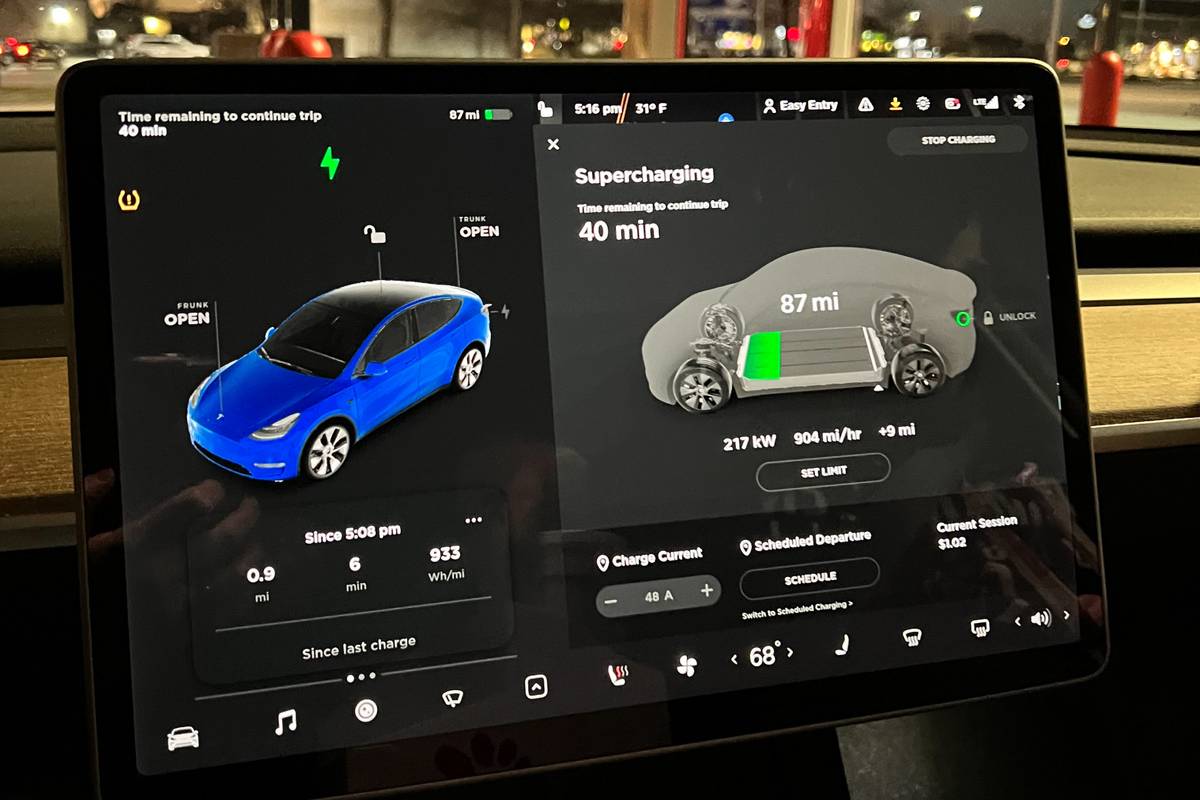
Model Y Miles Traveled Versus Range Used
Our Model Y has a maximum EPA-rated range of 326 miles, so I optimistically figured we’d make one charging stop along the way. I was wrong. Each 355-mile trip required two stops for Supercharging because of how much range was sapped by the conditions of the trip: weather, passengers, cargo and highway speeds. No leg of the trip exceeded 155 miles before being routed to a Supercharger.
The first leg of the trip from Chicago to Normal, Ill., was 141 miles, but the Model Y used 224 miles of rated range to get there. According to Tesla, the Model Y’s main range display is calculated from battery energy and predicts range using EPA consumption; it doesn’t account for driving patterns or external conditions (those are displayed in a separate menu). Cold temperatures impact battery range, and the average outside temperature for that leg was 31.8 degrees. A study by AAA found the range loss at 20 degrees Fahrenheit to be about 40% lower than at 75 degrees for the average electric vehicle.
The second leg yielded roughly the same results. The trip from Normal, Ill., to Collinsville, Ill., was 155 miles in distance but used 250 miles of range. The outside temperature warmed during that leg to an average 53 degrees. The third leg was brief, with just 32 miles of distance and 40 miles of range used. It was 64 degrees outside.
For the return trip, we piled the family, luggage and gifts back into the Model Y. The skies were clear, but the temps dropped as we headed north. We used the TeslaFi data logger to track all aspects of the trip.
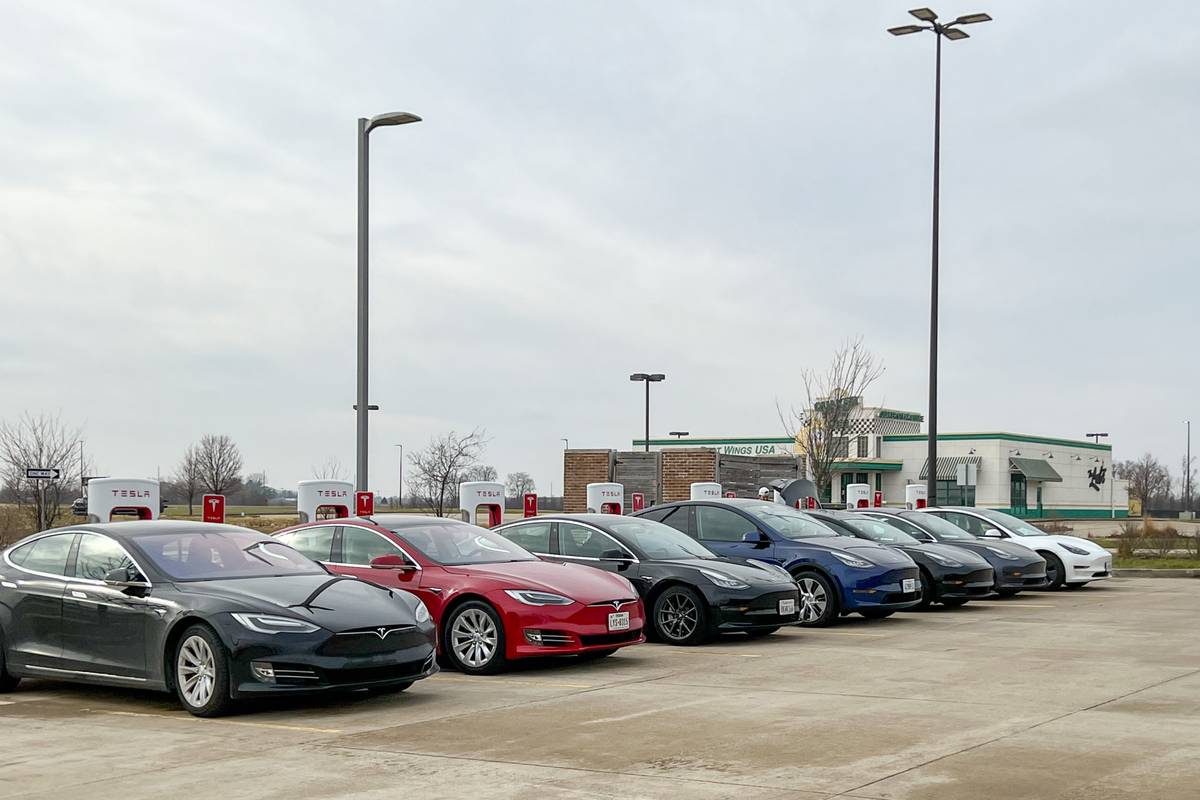
Our first stop of the trip home seemed to come up quickly — mostly because I hadn’t charged the Model Y’s battery to capacity. I had been playing around with setting charging limits on the battery and had only charged it to roughly 250 miles, or 80%. Transparency is no fun when you have to admit to dumb mistakes like this. With the exception of road trips, Tesla recommends limiting charging to 90% in daily use and only charging to 100% when you need the maximum range.
We made it from Ballwin, Mo., to Springfield, Ill., a 115-mile distance that used 181 miles of range. The outside temperature averaged 58 degrees.
The Supercharger station in Springfield was in heavy use, and when we plugged in, we were alerted via the screen that we’d only be able to charge to 80% battery capacity (even though I adjusted the charging capacity back to 326 miles). Because my husband and I figured we’d be making another stop along the way, we didn’t worry about charging to only 80%.
For the second leg, we traveled the longest distance of the day at 131 miles and used 210 miles of range. The outside average temperature dropped to 49 degrees. As we pulled up to the Supercharger in Dwight, Ill., we got an alert that the battery was low and “there will be significantly less energy available from your battery if it gets colder. We recommend charging now.” At that point, the Model Y showed 65 miles of range remaining.
After charging the Model Y for the second time, we headed to Chicago, traveling a distance of 87 miles and using 113 miles of range. The average outside temperature fell to 44 degrees.
The entire trip’s measured efficiency (actual miles traveled divided by the predicted range) averaged 65%, according to data from TeslaFi. If we were only able to wring 65% of range out of the Model Y’s 326-mile rated range under these weather and driving conditions, that means we’d only have a little over 200 miles of total range.
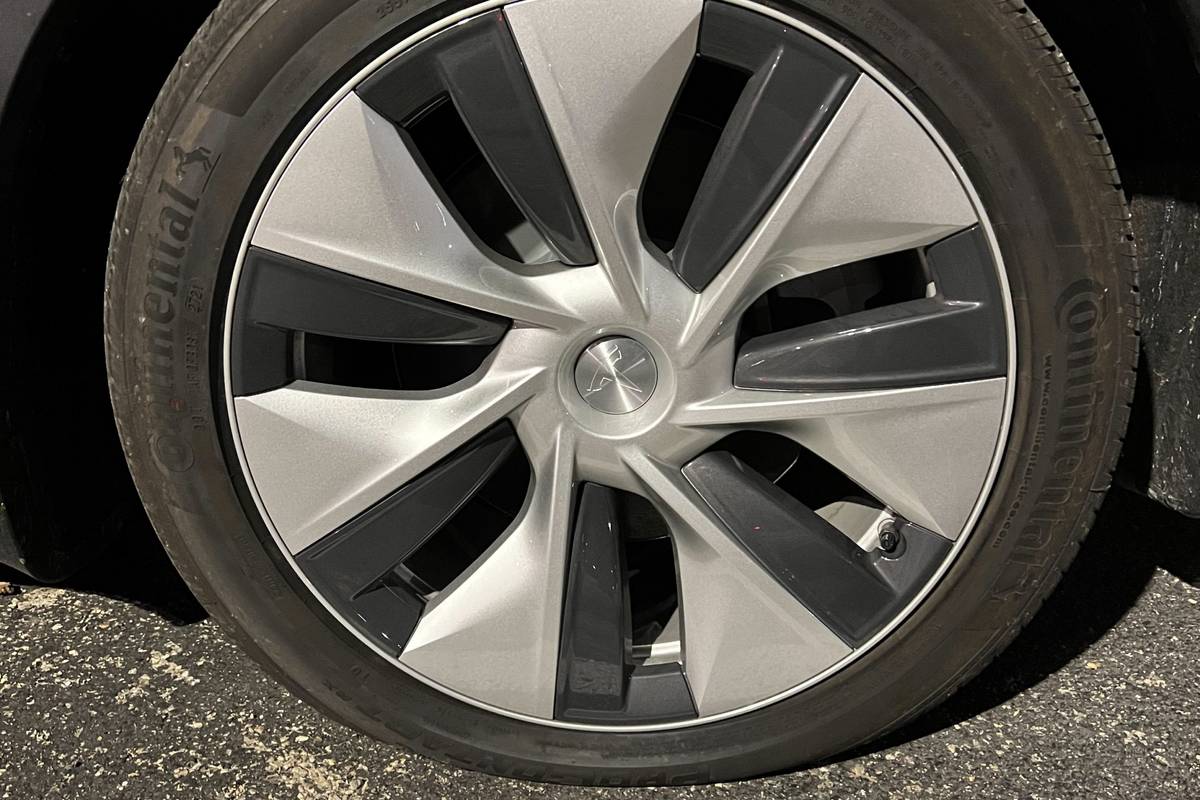
- ${price_badge()}
- ${ami_badge()}
- ${battery_badge()}${ev_report_link()}
- ${hot_car_badge()}
- ${award_badge()}
- ${cpo_badge()}
${price_badge_description}
${ami_badge_description}
The EV Battery Rating is based on this vehicle's current expected range relative to the vehicles expected range when new. ${battery_badge_text}
Certified cars are manufacturer warrantied and typically go through a rigorous multi-point inspection.
This car is likely to sell soon based on the price, features, and condition.
${award_blurb}
${award_two_blurb}
Shop the 2021 Tesla Model Y near you


Flat Tires Suck, But Tesla’s Roadside Assistance Was Fantastic
No road trip is complete without a little drama. For us, that “excitement” happened on the first day when we got a flat tire after getting off the highway to grab dinner and charge at a Supercharger in Normal, Ill.
As we pulled into a fast-food restaurant, I noticed that the tire pressure monitor was red. Thinking the pressure may have dropped due to the cold, we made our way over to the Supercharger and plugged in, where I tried to figure out what was going on. The car couldn’t tell me the pounds per square inch, or psi, until we were moving again, so there was nothing to do but wait.
Once we’d finished charging, I decided to drive to a nearby gas station to put air in the tire, and in that brief drive, the Model Y flashed the tire’s psi: 15. It’s supposed to be 44 psi. This was clearly a much more serious problem than a slightly low psi. I drove back to the Supercharger, put the car in Park and opened the Tesla app to use roadside assistance.
Within a few minutes, I was texting with a service advisor on next steps. I could either have the Model Y towed to the Tesla Bloomington-Olympia Drive service center, a mere 5 miles away, or I could go with a tire shop. It was getting late and the likelihood of a tire shop getting us in for service seemed low, so I opted for the Tesla service center.

Tesla alerted me — again via text — that a tow truck had been dispatched and would arrive in 40 minutes. Once the tow truck arrived, it was quickly loaded onto the flatbed (and at that point the tire’s psi had dropped to 5). It was too late to have the Model Y serviced, so my family ended up staying overnight at a nearby hotel.
Later that night, Tesla sent me a service estimate that included both a tire replacement and a tire repair. I authorized both possible repairs, allowing the service technicians to inspect the tire and make the fix. While some might be concerned that this preauthorization means they’ll be paying for the most expensive option, I was only concerned about getting back on the road before noon as we had plans later that day.
I was able to chat with a service technician via the app to get more information about when the repair would be completed. They ended up replacing the tire rather than repairing it. The new tire cost $300, including the $5 tire-disposal fee. With labor and taxes, the total was $380.81.
I took a ride-share service to the service center, where I assumed the car would be outside, ready for me to pick up. It wasn’t, and when I went into the service center’s waiting room, there was no one to greet me or give me guidance as to where to get my car. I tried texting the technician via the app to let him know I had arrived and waited patiently (not my strong suit). Eventually, I popped my head into a door marked “Employees Only” and asked about picking up my car. I was able to chat with the technician, see the damaged tire, then grab the Model Y and head back to the hotel to pick up my family.
Charging Time Is a Factor for EV Road Trips
Road-tripping in an EV means your trip will take longer than it would in a gas-powered vehicle. The total time spent at Superchargers for the round trip was 2.5 hours, and it cost a total of $60.26. For the trip from Chicago to Ballwin, we spent 84 minutes charging the Model Y, which cost $31.75. For the return trip to Chicago, we spent a little less time at the Superchargers, with 65 minutes logged for a cost of $28.51.
I’m typically the kind of road-tripper who wants to get to their destination as quickly as possible, so spending more than an hour charging the car per trip should have been maddening. For the most part, it wasn’t. We managed to combine charging time with eating a meal (yes, inside the car) or popping into a nearby gas station for supplies.
I’m ready to try another road trip in an EV (ideally, not a Tesla) to learn how the experience compares when not relying on Tesla’s Supercharger network as well as what sort of distance I’m able to cover.
More From Cars.com:
- We Bought a 2021 Tesla Model Y
- Electric Vehicles: Understanding the Terminology
- Electric Cars With the Longest Range
- What’s New With Electric Vehicles for 2022?
- 2022 Hyundai Ioniq 5 Gets Maximum EPA Range of 303 Miles
Cars.com’s Editorial department is your source for automotive news and reviews. In line with Cars.com’s long-standing ethics policy, editors and reviewers don’t accept gifts or free trips from automakers. The Editorial department is independent of Cars.com’s advertising, sales and sponsored content departments.
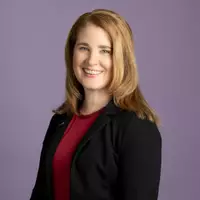
Editor-in-Chief Jennifer Newman is a journalist with more than 25 years of experience, including 15 years as an automotive journalist at Cars.com. Jennifer leads the Editorial team in its mission of helping car shoppers find the vehicle that best fits their life. A mom of two, she’s graduated from kids in car seats to teens behind the steering wheel. She’s also a certified car-seat technician with more than 12 years of experience, as well as member of the World Car Jury, Automotive Press Association and Midwest Automotive Media Association. LinkedIn: https://www.linkedin.com/in/jennilnewman/ Instagram: @jennilnewman
Featured stories




